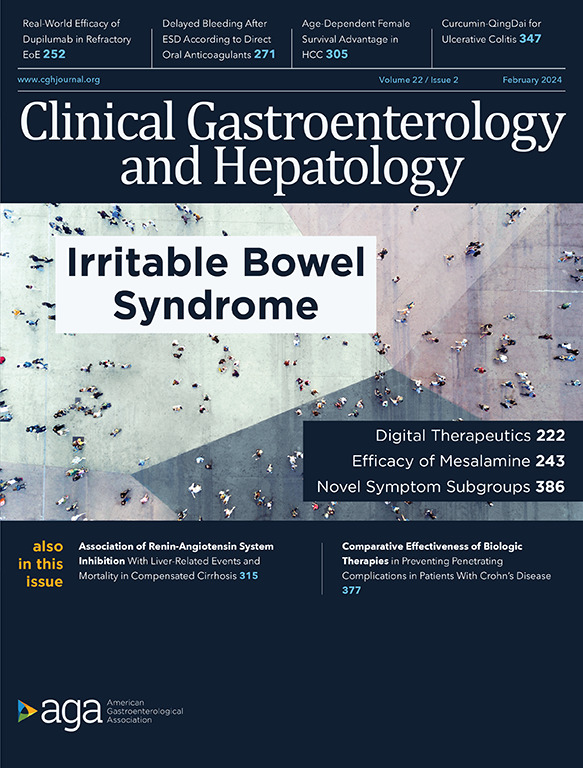用于检测无法切除的肝癌患者高风险静脉曲张的无创模型的开发与验证
IF 12
1区 医学
Q1 GASTROENTEROLOGY & HEPATOLOGY
引用次数: 0
摘要
背景和目的:无创静脉曲张风险分层系统尚未在肝细胞癌(HCC)患者中得到验证,这给接受全身性 HCC 治疗的患者带来了后勤障碍。我们的目的是开发并验证一种无创算法,用于预测无法切除的 HCC 患者的静脉曲张:我们在美国 21 个中心开展了一项回顾性队列研究,研究对象包括 2007 年至 2019 年期间确诊的不可切除 HCC 和 Child Pugh A5-B7 肝硬化的成年患者。我们纳入了在指数成像后 12 个月内但在 HCC 治疗前完成食管胃十二指肠镜 (EGD) 检查的患者。我们将队列分为 70:30 的训练集和验证集,目的是最大限度地提高阴性预测值 (NPV),避免低风险患者接受 EGD:我们共纳入了 707 名患者(中位年龄 64.6 岁,80.6% 为男性,74.0% 为白人)。从 HCC 诊断到 EGD 的中位时间为 47 天(IQR:114 天),25.0% 的患者有高风险静脉曲张。在验证队列中,仅使用临床变量的模型的净现值为 86.3%,而整合临床和影像学变量的模型的净现值为 97.4%。临床和成像模型可避免半数以上的低风险患者接受胃肠造影检查,但却误诊了7.7%的高风险患者:结论:结合临床和影像学数据的模型可以准确预测 HCC 患者是否存在高危静脉曲张,并避免许多低危患者在开始系统治疗前接受胃食管造影检查,从而加快患者的治疗,避免治疗延误。本文章由计算机程序翻译,如有差异,请以英文原文为准。
Development and Validation of a Noninvasive Model for the Detection of High-Risk Varices in Patients With Unresectable Hepatocellular Carcinoma
Background & Aims
Noninvasive variceal risk stratification systems have not been validated in patients with hepatocellular carcinoma (HCC), which presents logistical barriers for patients in the setting of systemic HCC therapy. We aimed to develop and validate a noninvasive algorithm for the prediction of varices in patients with unresectable HCC.
Methods
We performed a retrospective cohort study in 21 centers in the United States including adult patients with unresectable HCC and Child-Pugh A5-B7 cirrhosis diagnosed between 2007 and 2019. We included patients who completed an esophagogastroduodonoscopy (EGD) within 12 months of index imaging but before HCC treatment. We divided the cohort into a 70:30 training set and validation set, with the goal of maximizing negative predictive value (NPV) to avoid EGD in low-risk patients.
Results
We included 707 patients (median age, 64.6 years; 80.6% male; 74.0% White). Median time from HCC diagnosis to EGD was 47 (interquartile range, 114) days, with 25.0% of patients having high-risk varices. A model using clinical variables alone achieved an NPV of 86.3% in the validation cohort, whereas a model integrating clinical and imaging variables had an NPV 97.4% in validation. The clinical and imaging model would avoid EGDs in more than half of low-risk patients while misclassifying 7.7% of high-risk patients.
Conclusions
A model incorporating clinical and imaging data can accurately predict the absence of high-risk varices in patients with HCC and avoid EGD in many low-risk patients before the initiation of systemic therapy, thus expediting their care and avoiding treatment delays.
求助全文
通过发布文献求助,成功后即可免费获取论文全文。
去求助
来源期刊
CiteScore
16.90
自引率
4.80%
发文量
903
审稿时长
22 days
期刊介绍:
Clinical Gastroenterology and Hepatology (CGH) is dedicated to offering readers a comprehensive exploration of themes in clinical gastroenterology and hepatology. Encompassing diagnostic, endoscopic, interventional, and therapeutic advances, the journal covers areas such as cancer, inflammatory diseases, functional gastrointestinal disorders, nutrition, absorption, and secretion.
As a peer-reviewed publication, CGH features original articles and scholarly reviews, ensuring immediate relevance to the practice of gastroenterology and hepatology. Beyond peer-reviewed content, the journal includes invited key reviews and articles on endoscopy/practice-based technology, health-care policy, and practice management. Multimedia elements, including images, video abstracts, and podcasts, enhance the reader's experience. CGH remains actively engaged with its audience through updates and commentary shared via platforms such as Facebook and Twitter.

 求助内容:
求助内容: 应助结果提醒方式:
应助结果提醒方式:


